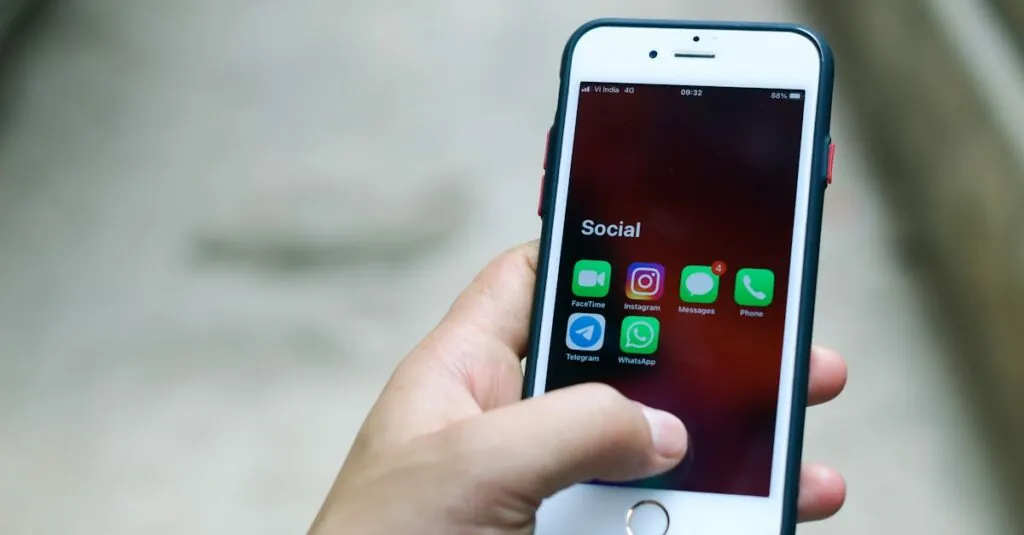Table of Contents
ToggleEver hit that dreaded “delete” button on your iPhone and instantly regretted it? You’re not alone! It’s like tossing your favorite pizza slice into the trash—painful and totally unnecessary. Luckily, finding those lost messages isn’t as impossible as finding a needle in a haystack.
Understanding Deleted Messages on iPhone
Deleted messages on an iPhone can often feel lost forever, but various methods exist for potential recovery. When a user deletes a message, it isn’t erased immediately from the device storage; instead, it enters a state where it may still be recoverable until new data overwrites it.
Apple’s Messages app stores deleted conversations in a recent deleted folder for a limited period. Users should check this folder if they’ve deleted a message recently. Accessing this space is straightforward: open the Messages app, tap “Edit,” and select “Show Recently Deleted.” This shows messages removed within the last 30 days.
Alternately, users can explore backups for retrieving deleted messages. iCloud usually backs up messages if enabled. Users can restore an iCloud backup by navigating to Settings, selecting the user’s name, proceeding to iCloud, and tapping “Manage Storage.” If messages are included in the backup, restoring the device from a backup frequently restores lost messages.
iTunes also presents another viable option. Users with computers can connect their iPhone, open iTunes, and initiate a device backup. Restoring from this backup may bring back deleted messages. However, it’s crucial to be aware that this process replaces current device data with backup content.
Some third-party recovery tools provide additional options for message retrieval. Tools designed for iPhone recovery might successfully recover deleted messages under particular conditions. Each method requires care, as the risk of overwriting data increases the longer a message remains deleted.
In sum, various strategies exist for locating deleted messages on an iPhone. Users need to act promptly and follow appropriate recovery steps to maximize their chances of retrieving lost communications.
Common Scenarios for Message Deletion
Users often face common scenarios when deleted messages occur on an iPhone. Understanding these situations helps in recovery efforts.
Accidental Deletion
Accidental deletion frequently leads to lost messages. Many users tap the wrong button or swipe incorrectly while managing their chats. Such mistakes can happen during routine tasks, causing frustration. Deleted messages may be found in the “Recently Deleted” folder within the Messages app. Messages there remain accessible for 30 days after deletion, allowing for easy recovery. Searching this folder should be a first step before exploring more complex recovery methods.
Intentional Deletion
Intentional deletion involves messages users decide to remove, often for organization or privacy reasons. Some individuals regularly delete conversations to declutter their messaging app. Although this practice can free up space, it poses the risk of losing important communications. Recovery options exist for these messages if backups were created beforehand. iCloud and iTunes backups offer reliable means to restore intentionally deleted messages. Users often overlook the necessity of maintaining up-to-date backups, which complicates retrieval in these cases.
Methods to Recover Deleted Messages
Recovering deleted messages from an iPhone involves various methods. Users can effectively retrieve lost texts through a few straightforward steps.
Checking Recently Deleted Folder
Checking the Recently Deleted folder serves as the first recovery step. Messages deleted within the last 30 days remain accessible in this folder. Users can navigate to the Messages app, scroll to find the folder, and examine its contents. If the desired messages are present, users can easily restore them with a tap. Quickly checking this option maximizes the chances of recovery, preventing further loss.
Using iCloud Backup
Using an iCloud backup provides another method for retrieving deleted messages. When iCloud backups are enabled, messages backs up automatically. Users must first access their iCloud settings, where they can find the backup section. From there, they can review the latest backup date and determine if it includes the lost messages. Restoration of the backup will replace current data, so caution is necessary. Selecting the appropriate backup ensures successful recovery.
Utilizing iTunes Backup
Utilizing an iTunes backup also helps recover deleted messages. Users with iTunes backups can connect their iPhone to a computer. After launching iTunes, they can select their device and navigate to the backup options. Options allow users to restore from the most recent backup. It’s important to note that this process replaces existing data on the device with backup content. Users should consider backing up current information before proceeding with this method for optimal results.
Third-Party Recovery Tools
Using third-party recovery tools can enhance the chance of retrieving deleted messages on an iPhone. These tools often specialize in recovering data that the device’s built-in methods cannot access.
Advantages and Risks
Third-party recovery tools provide several advantages. They can recover messages beyond the 30-day window of the Recently Deleted folder. Some tools also provide a preview option, allowing users to view recoverable messages before initiating a restore. On the other hand, risks accompany their use. Some tools may not be genuine, potentially leading to data loss or privacy breaches. It’s crucial to research each tool’s reliability by checking reviews and ensuring they come from reputable sources.
Recommended Tools
Numerous third-party tools exist for message recovery. Dr.Fone by Wondershare ranks highly for its user-friendly interface and effectiveness. EaseUS MobiSaver and Tenorshare UltData also offer solid performance and recovery options. Each tool has distinct features, so users can compare them based on their specific recovery needs. Most of these tools support both Windows and Mac systems, expanding accessibility for different users while maintaining compatibility with various iOS versions.
Accidentally losing important messages on an iPhone can be frustrating but recovery is often within reach. By taking the right steps and utilizing available tools users can successfully retrieve deleted communications. Checking the Recently Deleted folder should always be the first action. If that doesn’t yield results exploring iCloud and iTunes backups offers further options. For those needing more advanced solutions third-party recovery tools can provide additional pathways to restoring lost messages. Staying proactive with regular backups can significantly reduce the risk of permanent loss. With these strategies in mind users can navigate the recovery process with confidence.







